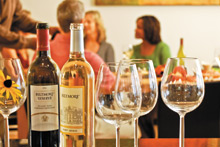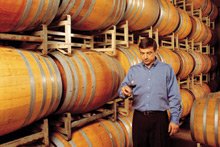For the winemaker, patience is more than just a virtue—it’s a necessity. And according to Biltmore wine master Bernard DeLille, a century’s worth is what it takes to establish what counts as history in the wine world. Everything he has to say about winemaking is sprinkled with the words “time” and “patience.” “It takes time,” DeLille stresses. “It is a slow process. You have to accept it as it goes.”

“To grow grapes the right way,” he explains, “you need to have a history. France has a history. California is starting to have a history.”
As any wine connoisseur knows, North Carolina only recently got serious about making wine. Grapes thrive in consistent weather, a rarity in this region. Western North Carolina is notorious for its unpredictable spring months, during which it’s not unusual to have frost one day and soaring temperatures the next. Jerry Douglas, senior vice president of marketing and sales, admits to feeling frustration with North Carolina’s weather. “You can’t make good wine without good grapes,” he says. “There’s variability year to year in terms of what Mother Nature gives us.” He also adds, “Finesse is required to make wine from grapes grown here, and I think Bernard has mastered that.”
It appears that the persistence of North Carolina’s growers is paying off. Hurrying to catch up and overcome its grape-less past, North Carolina ranks as the country’s 10th biggest generator of wine and grapes, according to the North Carolina Department of Commerce.
William A. V. Cecil, grandson of George W. Vanderbilt, was similarly undeterred by North Carolina’s lack of winemaking history. He believed planting a vineyard was yet another step in furthering his grandfather’s vision of making the estate a self-sustaining one. Under Cecil’s guidance, the first Biltmore vineyard was planted in the 1970s.
Since then, the Biltmore winery has come a long way in a relatively short amount of time. Ten years ago, the winery was producing approximately 68,000 cases of wine annually and selling in only eight or nine states in the Southeast. “Most of the sales were taking place to visitors on the estate,” says Douglas.

And mostly, they were selling white wine. Estate visitors apparently hadn’t gotten the memo circulating in the late 1990s touting red wine’s health benefits. While white wine remains the winery’s bigger seller, red wine sales are finally starting to rise. Douglas believes that the American drinker’s palate has begun to evolve: “A lot of people are looking at red wine because the taste is a little more complex.”
Nearly 30 years after the sale of the very first bottle of Biltmore wine, the winery is exceeding corporate expectations.
“We’ve re-defined ourselves,” says wine marketing manager Heather Jordan, explaining that the winery welcomes “a lot of different kinds of customers with different needs and wants.” That approach influenced an aesthetic makeover the Biltmore winery unveiled this fall.
The new branding strategy includes re-designed labels and five wine tiers. The popular Biltmore wines are still produced with the average wine drinker in mind—one who looks for a pleasant taste and consistent prices—although the bottles now sport a simple label featuring a depiction of the Biltmore house. The new lines include red, white and rosé Century Wines, meant to complement a wide range of meals; Biltmore Estate Wines highlighting “North Carolina’s best in grapes”; and revamped Biltmore Reserve Wines, designed for “the knowledgeable wine connoisseur.” Lastly, there is the G. W. Vanderbilt Private Collection, a conceptual tier that is not yet available to the public.
Although the arrival of the tiers has been recent, Jordan is already receiving comments about the winery’s branding and labels, saying, “We’ve had a lot of positive feedback from distributors and retailers.”
North Carolinians and estate tourists are not the only ones taking notice of Biltmore’s wines, which are being recognized throughout the states and abroad. Internationally, the Biltmore Estate Pinot Grigio won the Distinguished Gold “Best of Class” in the 2008 Lodi International Wine Awards. Its fellow wine, the Biltmore Estate Sauvignon Blanc, took home gold in the 2008 San Francisco Chronicle Wine Competition. Currently, Biltmore Estate wine is being shipped to 16 states. Residents of Alabama, Delaware, Florida, Georgia, Illinois, Kentucky, Louisiana, Maryland, Mississippi, Ohio, Pennsylvania, South Carolina, Tennessee, Virginia, Washington, D.C., West Virginia, and of course, North Carolina, will find Biltmore Estate wine sold in their grocery stores and wine markets.
As for the future of the winery, there are large-scale ideas in the planning stages. Expect to see Biltmore wine sold not only in all 50 states one day, but globally as well. Douglas is staunch in his belief that Biltmore wine can compete worldwide. “What I like about our wines,” he says, “is that they have complexity without trying to be overpowering; there’s subtlety in the wines.”
Since the first large grape crush in 1984, the estate is currently producing 170,000 cases of wine annually. Douglas’ dream is a production of 1 million cases. But quality is an important consideration; Douglas says the numbers won’t go up overnight. The folks at the winery understand that it will take time, patience, and effort before Biltmore goes global. But, Douglas adds, “We’re only limited by our creativity and our ability to execute. We like being in this business—it fits for us.”
[Viktorija Krulikas is a contributing writer.]



Before you comment
The comments section is here to provide a platform for civil dialogue on the issues we face together as a local community. Xpress is committed to offering this platform for all voices, but when the tone of the discussion gets nasty or strays off topic, we believe many people choose not to participate. Xpress editors are determined to moderate comments to ensure a constructive interchange is maintained. All comments judged not to be in keeping with the spirit of civil discourse will be removed and repeat violators will be banned. See here for our terms of service. Thank you for being part of this effort to promote respectful discussion.